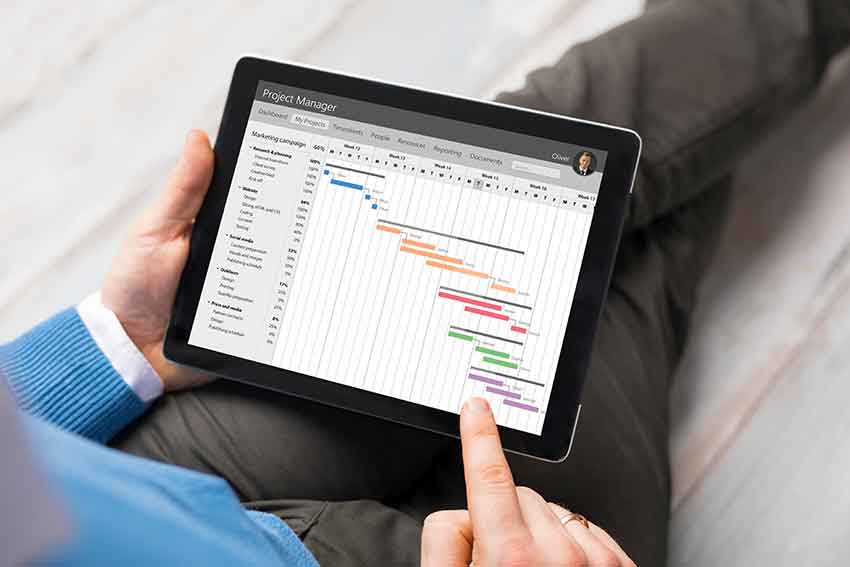Show:
7 Effective Task Management Strategies For Project Task Management
What is a project if not a subset of multiple tasks? When you’re the project manager, you need everyone, including you, to be on their best behavior. After all, you have a deadline to hit. If you don’t have a proper strategy for task management that everyone in your team can follow, the end result might not be to your satisfaction.

So, let’s take a look at 7 effective task management strategies for project task management before your next project hits the road.
7 successful task management strategies for project task management
1. Get a project management tool
If you’ve been trying to manage your project without a project management tool all this time, it’s time to change your strategy. Project management systems like Clovine intuitively take care of a lot of the hard parts of a project. These could include adjusting the project schedule and frequent reminders of deadlines.
The task summary reports help you keep an eye on the progress of the project at a glance. Function such as feed allows you to communicate with your team members on the status of the project. You can also form your own to-do lists. The system will link them to the project if there’s any relation.
Project management software is way more effective for keeping track of your tasks than writing them down on a sheet. Or worse, trying to handle everything in your mind.
2. Choose a project board
Analyze the type of project you are undertaking. Some might be better suited for a mind map view where the majority of the tasks are dependent on the associated events with a concept.
The Gantt view is better for projects with a tight schedule. It also deters you from jumping to another task until the first one is complete.
If you go for the Kanban board view, you have an effective and simple project board. All the tasks are almost listed like a to-do sheet and you see the status of each task at a glance.
Choosing the project board is important for task management. The view type can have a deep effect on the progress of the project. If you use the wrong board view for the project, important tasks could get lost. Generally, people opt for Gantt view for complicated projects.
For creative projects, people seem to have a preference for the mind map view.
3. Allocate tasks
Once the project and tasks name has been established, it’s time to choose team members to assign to the tasks. However, before you do, hold a group meeting. Ask them what tasks they want to focus on and discuss their importance with them. When they know the extent of their responsibility, they are motivated to finish it faster.
Tell them why you want to assign a particular task to them and see if they agree. This also shows that you have a level of trust in the team. Since they become aware of your dependency on them, they do their best to not let you down.

4. Set realistic deadlines
Setting deadlines isn’t about just setting one for each task. It is about accounting for delays, task misdirection, and marking the task by priority. The time limits should be realistic. Don’t set deadlines that no one can achieve and then have the team panic because they see the big red mark of overdue tasks.
5. Review tasks
Check on the progress of the tasks every week. Ask your team member who is assigned to the task for updates from time to time. However, you should do this in moderation. Don’t become a micromanager in the process.
Just leave a small reminder that it would be nice if the task is done within a certain time period.
Also, set milestones for tasks to mark the next phase of a project.
6. Take risks into account
You can prepare as much as you want and still some things will be out of your control. In times like those, you have to take a deep breath and plan forward. Don’t dwell on what went wrong. Instead, focus on how it can be corrected.
The Clovine software has the perfect feature for such a situation. There is a comparison tool that lets you compare different files and see where they differ. If someone hasn’t done a task correctly and has uploaded a second file with corrections, you can use the compare tool. This way, you know they understood the assignment properly this time.
7. Be receptive to feedback
No matter how much you preplan the timeframe of a task, things change. Sometimes, new things have to be added. Other times, small mistakes occur to delay the tasks.
Overall, you have the option of leaving feedback with your team on what went wrong. At the same time, be open to feedback from their end. If they think a particular task should be done differently from the way you planned, listen to their reasoning. Whether you agree or not, you ought to listen. Even if it doesn’t work out this time, you can do things a particular way in the future.
It is important to have a collaborative mindset. Don’t work on your own. Ask for help from the team if you need it and help them back.
Final Thoughts
The crux of a good, effective task management strategy is to have an open mind, account for risks, and communicate with your team members. As long as you have good project management software where the entire team can communicate with each other, the project will be done by the time the final deadline approaches, even if you are working remotely.

 Return to Previous Page
Return to Previous Page








